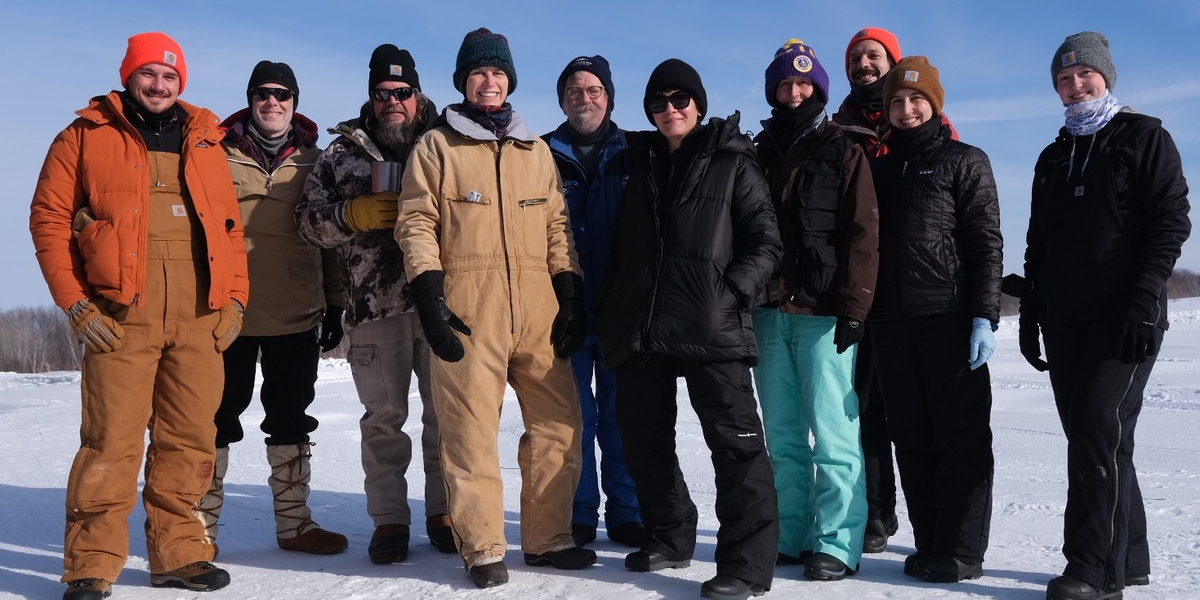
A helicopter hangs low over the icy horizon. The aircraft and its cargo — a strange, heavy object held securely to the ‘copter by a canvas sling — inch slowly and gingerly toward their delivery site. The object is a deer. And it’s wearing an eye mask, not unlike the kind you’d use to nap in an airplane.
“I will never, ever, ever forget the first time a deer came toward me hanging from a helicopter in a sling. It’s a surreal sight,” says Meggan Craft, an infectious disease ecologist and associate professor in the Department of Ecology, Evolution and Behavior who currently leads research investigating the movement of deer and disease spread in suburban areas.
Deer are carriers of SARS-CoV-2 (the virus that causes COVID-19) and Lyme disease — both of which also pose major health risks to humans. Investigating what factors shape the spread of disease among wildlife can assist researchers in modeling disease transmission across multiple scales and environments.
Airborne cervids
It’s just another Wednesday for the helicopter pilots, whose entire careers are spent transporting wildlife for conservation purposes all over the world. But for Craft (and the deer) every second of the helicopter team’s time counts. The first goal is safety for all involved. The second is to collect as much data as time — and weather — allows.
“We put approximately 40 GPS collars out on deer last year at Elm Creek Park Reserve Park Reserve. This year we wanted to recapture as many of those 40 deer as possible and put out 14 more collars; I think we got only seven collars out, and no recaptures,” says Craft, who says they had to cut their capture days this winter short because of poor weather. Or perhaps the weather was too fair?
“[While retrieving a deer on foot], the helicopter folks crashed through ice in a shallow stream that you would not expect to be running in early January,” says Craft. A snow-laden topography also makes it easier to identify deer as they lope through the landscape.
The helicopter team captures the deer by launching a net from the passenger seats. From the ground, they dress each deer in its fancy sling and mask, then fly the deer to the research team. The team quickly (and carefully) place a GPS collar and take a blood draw and oral and nasal swab to test for viruses and antibodies before releasing the deer back into the “wilderness” of Elm Creek Park Reserve.
Tracking disease transmission
Craft’s team can determine if a deer has an active strain of SARS-CoV-2. But they can also detect if a deer has contracted the disease previous to their captures. If they can re-capture their subjects, even once, they may be able to determine if the disease transmission has anything to do with the spaces they spend their time in.
For example, they tested negative for SARS-CoV-2 in their first capture, but by round two they’re positive. Tracking data from the GPS collars could help Craft figure out where the deer might contract the disease — and if they spread it to one another.
“Are they hanging out in residential areas? Or at the dog park? Are they congregated around a food source?” asks Craft, who notes that deer frequent human-dominated environments. “[A previous study found] a high incidence of SARS CoV-2 in the deer population. We’re wondering, could deer become a reservoir for this virus?”
The movement of deer can lead to contacts between deer from different social groups, which can lead to disease spread. Craft’s data from last year’s captures at Elm Creek Park Reserve suggests that males have more COVID antibodies than females.
“It’s possible the males had more antibodies because we sampled them in January, and they just finished their breeding season,” says Craft. “In the breeding season, they run around and mate with different groups of females. They have a bigger home range.”
As for this year, Craft’s research depends on another cold swing coming in and perfectly aligned schedules with the helicopter team. “This weird winter may interfere with our capture plans,” says Craft. “But we’ll adjust.” — Adara Taylor
This work was made possible by a Cooperative Agreement from the United States Department of Agriculture’s Animal and Plant Health Inspection Service (APHIS). It may not necessarily express APHIS’ views. Funding was provided by the American Rescue Plan Act of 2021.
Watch local news segments about this research at WCCO (short and full length versions) and CCX.